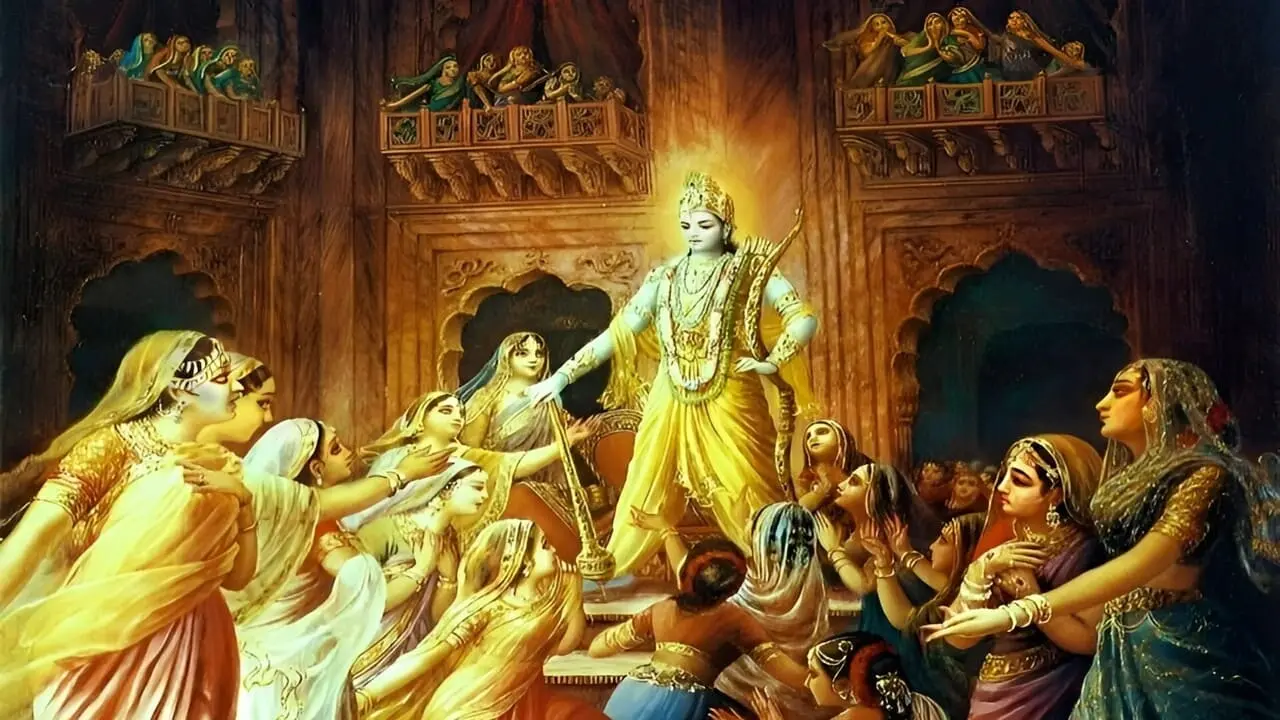The story of Krishna’s marital journey begins with his eight principal wives: Rukmini, Satyabhama, Jambavati, Kalindi, Mitravinda, Nagnajiti, Bhadra, and Lakshmana. Each of these women embodies unique virtues and qualities, symbolizing different aspects of devotion and love towards the divine.
Rukmini, the princess of Vidarbha, fell deeply in love with Krishna, despite being betrothed to the tyrant king Shishupala. She sent a message to Krishna expressing her desire to elope with him. Krishna, moved by her devotion, abducted her on the day of her swayamvara, a choice ceremony. This act of love initiated a series of events leading to their sacred union.
Satyabhama, the daughter of King Satrajit, was known for her unparalleled beauty and fiery nature. Despite being married to Krishna, she often struggled with jealousy, particularly towards his other wives. However, her devotion to Krishna never wavered, and she accompanied him in battles against demons and evil forces.
Jambavati, the daughter of the bear king Jambavan, married Krishna after he defeated her father in battle. Her marriage to Krishna symbolizes the bond between strength and devotion. Jambavati bore Krishna several children, including Samba, who played a significant role in later narratives.
Kalindi (Yamuna), the river goddess, was deeply in love with Krishna and yearned for union with him. She performed intense penance to win his favor and eventually married him. Kalindi represents purity and serenity, and her marriage to Krishna signifies the harmonious blending of the divine with the mortal.
Nagnajiti, also known as Satya, was the daughter of King Nagnajit of Kosala. Krishna competed in the svayamvara arranged by Nagnajit, and as per the set rules, he brought seven ferocious bulls under control by tying a noose around each of them, thus winning Satya as his wife.
Mitravinda, the daughter of King Jayasena of the kingdom of Avanti. She chooses Krishna as her husband in a svayamvara ceremony, in which a bride chooses a groom from assembled suitors. However, her brothers do not like it and forbid the marriage. They join forces with the Kauravas and fight Krishna. Krishna defeats the princes and takes Mitravinda away forcibly, as the other suitors keep looking.
Bhadra, was the daughter of King Dhrishtaketu and his wife Shrutakirti, the sister of Kunti and and cousin of Vasudeva (Krishna’s father) and thus Krishna’s second cousin. Bhadra’s five brothers headed by the eldest prince Santardana married Bhadra to Krishna.
Beyond the limelight of the principal wives lies a lesser-known tale of Krishna’s marriage to 16100 junior wives. These unions were not born out of romantic entanglements but rather a noble quest to protect and uplift the honor of the womenfolk who were held captive by the demon Narakasura.
Legend has it that Narakasura, a powerful demon, had imprisoned thousands of women in his palace, depriving them of their freedom and dignity. Hearing their plight, Krishna, in his boundless compassion, embarked on a divine mission to rescue them.
With his divine prowess, Krishna defeated Narakasura and liberated the captive women, ensuring their safety and restoring their honor. In a gesture of compassion and solidarity, he accepted them as his wives, bestowing upon them the status and respect they rightfully deserved.
These 16100 junior wives, although lesser-known in popular narratives, symbolize Krishna’s unwavering commitment to justice, equality, and compassion. Their inclusion in Krishna’s divine consort further enriches the tapestry of his divine leelas, illustrating the boundless capacity of love to transcend boundaries and uplift the oppressed.
One of the most captivating aspects of Krishna’s marital life is the notion that he simultaneously resided with each of his wives in their respective palaces. This divine phenomenon, known as the “Raslila”, transcends the limitations of time and space, illustrating Krishna’s omnipresence and omnipotence.
In this celestial dance of love, Krishna manifests himself in myriad forms, showering each of his wives with undivided attention and affection. Through this mystical union, he teaches us the essence of true devotion, reminding us that love knows no bounds and that the divine resides within each of us.
The saga of the wives of Krishna is not merely a tale of conjugal bliss but a profound allegory of spiritual awakening and divine love. From the eight principal wives to the multitude of junior spouses, each character symbolizes a facet of devotion and reverence towards the divine. Through their stories, we are invited to embark on a journey of self-discovery and transcendence, guided by the timeless wisdom of Lord Krishna.






